Are you unsure How To Write Photo Credits correctly? dfphoto.net provides a complete guide to help you master photo attribution, understand image licensing, and protect yourself from copyright issues. This guide covers everything from basic credit formats to the specific rules of popular platforms like Facebook, Instagram, and WordPress, ensuring your images are properly credited and compliant with legal requirements.
1. Understanding Image Credits
Image credits are essential. It’s all about giving proper attribution to the image owner, which is a respectful way to say thanks and is sometimes a requirement to use an image. They transparently showcase that the image doesn’t belong to the user but is the visual property of a certain image owner, and also give a fair warning to others that they too must follow the image owner’s terms and conditions if they would like to use that piece of work. Typically, this includes the image owner’s name and a copyright notice.
 Melinda Gimpel's stunning landscape photo, properly credited to acknowledge her creative work.
Melinda Gimpel's stunning landscape photo, properly credited to acknowledge her creative work.
Photo by Melinda Gimpel
1.1 Why Is Giving Image Credit Important?
Giving credit where credit is due shows respect and benefits both the image owner and the user. For image owners, it acknowledges their work, advertises their talent, and reinforces the terms of their image license. For image users, it’s a law-abiding behavior and ensures legal compliance, especially with licenses like Creative Commons.
1.2 What Happens If You Don’t Give Credit?
Failing to give proper image credit can lead to legal issues. Using an image without permission, even if credited, can result in copyright infringement claims. It’s always important to get explicit permission from the rights-holder or secure a license before using any image.
2. Key Terms for Image Credits
Understanding the different terms and conditions associated with image usage is vital for compliance. These terms dictate how you can use an image and what type of credit is required.
| Term | Description |
|---|---|
| Copyright | Exclusive legal right to distribute, reproduce, display, perform, and create derivative works from an original work. |
| Image License | Permission granted by the image owner that outlines how the image can be used. |
| All Rights Reserved | Indicates that the image owner retains all rights and requires explicit permission for any use. |
| Some Rights Reserved | Image owners can reserve certain rights, so carefully review the specific terms to understand usage conditions. |
| Creative Commons (CC) | Legal framework allowing copyrighted work to be distributed under specific conditions set by the image owner. Learn more about the seven types of Creative Commons licenses here. |
| Fair Use | Allows the use of copyrighted material for educational, personal, research purposes, or if it benefits the public. |
| Public Domain | Indicates the absence of copyright, allowing unrestricted use without permission or legal restrictions. |
Understanding these terms helps you navigate image usage and properly credit visual content.
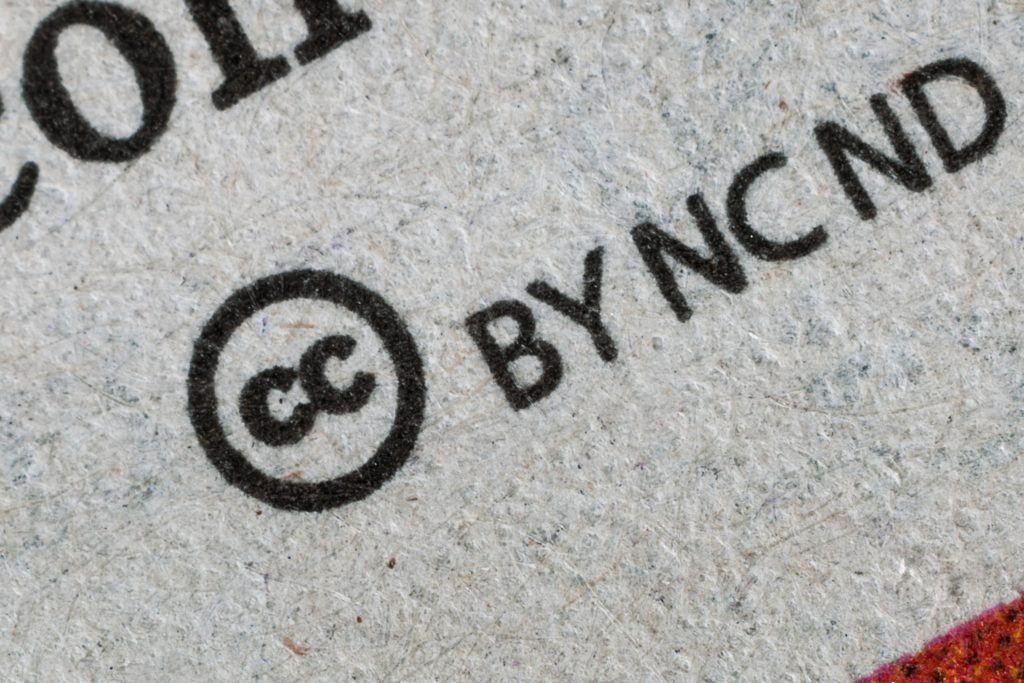 Umberto's urban cityscape, exemplifying the necessity for clear and visible image attribution.
Umberto's urban cityscape, exemplifying the necessity for clear and visible image attribution.
Photo by Umberto
3. Step-by-Step Guide to Giving Image Credits
Crediting images correctly involves several steps.
3.1 Ensure Usage Rights
Always confirm that you have the right to use the image. Without proper permission or licensing, using an image, even with credit, can lead to legal trouble.
3.2 Understand Usage Terms
Learn how you can use the image. Some owners restrict usage by platform (online vs. print) or by purpose (advertisement vs. informational).
3.3 Placement
Place the credit adjacent to the photo, typically below it or along one edge.
3.4 Visibility
Make the credit noticeable and readable. Use a font style and size that is easy to see and understand.
3.5 Follow the Template
Use this template unless specific terms require modification:
- [Image owner’s name]
- [Title of work]
- [Date of creation]
- [Link to the image owner/ source]
Example: Photographer Penny, “Rockefeller Center”, 2021, via www.pennyphotos.co.uk
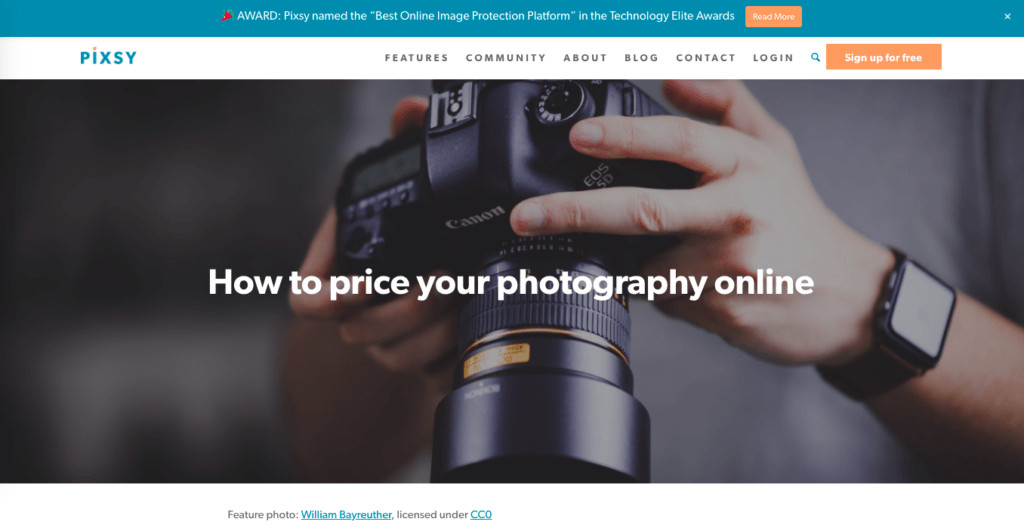 An image credit example from a Pixsy article.
An image credit example from a Pixsy article.
An image credit example from a Pixsy article_
4. Image Credit Rules on Popular Platforms
Different platforms have specific guidelines for image usage and crediting. Understanding these rules is crucial for avoiding copyright issues on social media and other online venues.
4.1 Facebook and Instagram Image Credit
Facebook and Instagram share the same copyright policy, as both are owned by Meta. The key rules to follow are:
- Only post content that doesn’t violate intellectual property or copyright.
- Only post images or content you created.
Common misbeliefs include thinking that modifying content sufficiently exempts you from copyright infringement or that finding content on the internet means it’s free to use. These are false.
According to a recent court case, websites are liable for copyright infringement when embedding content without permission. Instagram updated its Terms and Conditions to require permission and/or a license before embedding a post.
4.1.1 Image Crediting Best Practices
- Give image credit to image owners following their platform-specific requests.
- Tag the image owner using the @ symbol if they are present on the platform.
- If the image was originally posted on the artist’s Facebook or Instagram, tagging may be sufficient after obtaining permission.
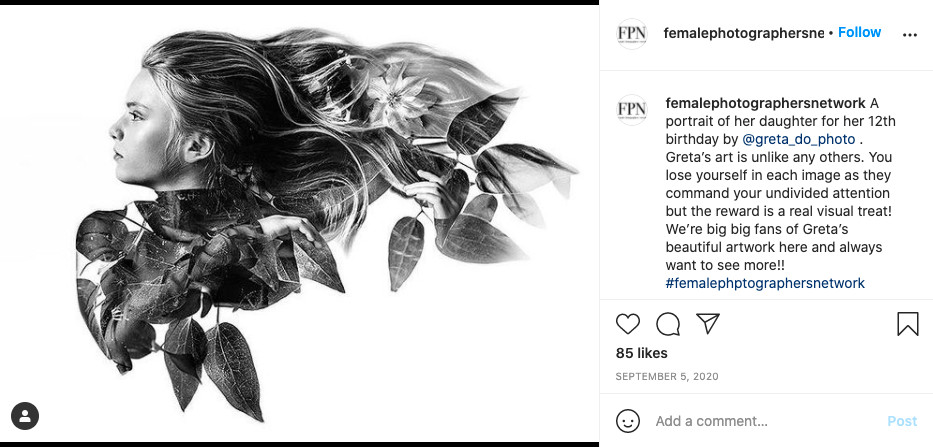 Greta Do, a photographer, is tagged in an Instagram post by The Female Photographers Network.
Greta Do, a photographer, is tagged in an Instagram post by The Female Photographers Network.
Example of sharing the work of photographer Greta Do and tagging her in an Instagram post by The Female Photographers Network
4.2 GIPHY Image Credit
GIFs, widely used in today’s meme culture, can easily lose image credits. GIFs are indeed subject to copyright, even if they often contain snippets of existing copyrighted material. This presents a unique legal challenge.
GIPHY addresses this in their community guidelines:
- “Credit the Community”: Use GIPHY’s share tools to credit the original creator.
- “Sharing”: Properly share and embed GIFs, complying with applicable laws.
If a GIF infringes copyright, GIPHY acts in accordance with the Digital Millennium Copyright Act (DMCA).
4.3 WordPress Image Credit
WordPress encourages content producers to include a clear copyright notice on their site, including their full name, site name, and current year, along with a statement of rights in the sidebar or footer. They also follow the DMCA process to protect images.
WordPress advises seeking permission from the image owner before using content and placing the image credit beneath the image, stating the creator’s name and linking to the source if possible.
 Nathan Lemon is the photographer behind the WordPress editor's 'Write caption' prompt.
Nathan Lemon is the photographer behind the WordPress editor's 'Write caption' prompt.
The “Write caption” prompt in the WordPress editor — Photo by Nathan Lemon
The WordPress editor now prompts users to give image credits. When uploading an image, a “Write a caption” title appears below it, making it a perfect spot for image credits.
4.4 Flickr Image Credit
Flickr supports 11 image license types, from “All Rights Reserved” to “No known copyright restrictions.” The default setting is “All Rights Reserved,” allowing creators to defend their work if legal problems arise.
As an image user, check the license and give credit accordingly. For CC licenses like “Attribution 2.0 Generic (CC BY 2.0)”, provide:
- Name of the creator and attribution parties
- Title of the material
- Copyright notice
- License notice
- Disclaimer notice
- Link to the material
4.5 Unsplash Image Credit
Unsplash offers freely-usable images that can be downloaded and used for free, even for commercial purposes, without permission. Although attribution isn’t required, giving credit is appreciated.
Unsplash provides a concrete example: “Photo by Jeremy Bishop on Unsplash”.
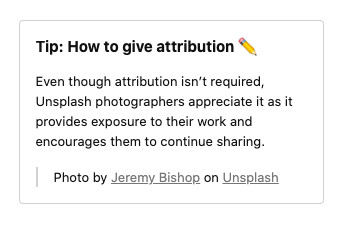 Attribution Guide – Unsplash License.
Attribution Guide – Unsplash License.
How to give attribution — Unsplash License
When a user clicks “Download free,” they’re prompted to give credit to the creator or copy the provided image credit text.
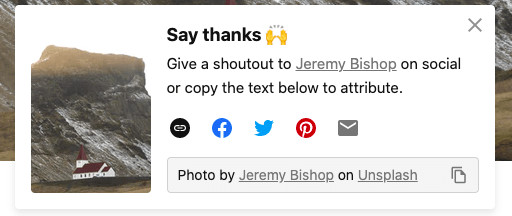 Jeremy Bishop's "Say thanks" pop-up photo.
Jeremy Bishop's "Say thanks" pop-up photo.
“Say thanks” pop-up for a photo by Jeremy Bishop
4.6 Google and Pinterest Image Credit
Referring to Google or Pinterest as the source is not sufficient. These platforms are search engines and social platforms, not original sources. Track the actual creator and/or owner to get their permission. If you can’t find the person, find another image that you can properly credit.
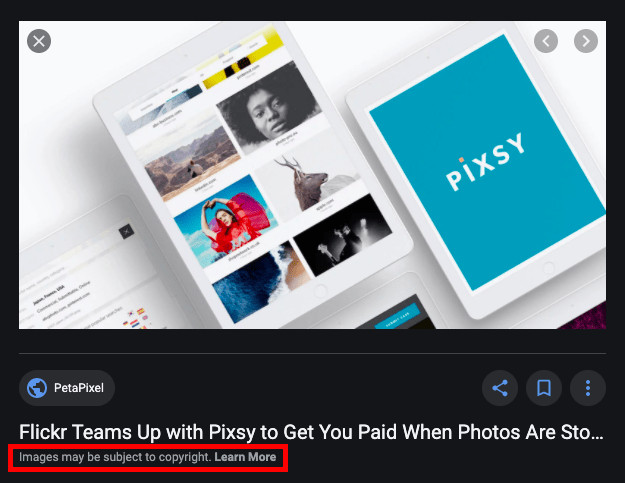 Google’s copyright alert in an image search.
Google’s copyright alert in an image search.
Google’s “copyright alert” in an image search
5. Image Licensing Explained
Navigating the world of image licensing can be complex, but understanding the basics helps ensure compliance and ethical usage.
5.1 Creative Commons Licenses: A Deep Dive
Creative Commons (CC) licenses offer a flexible way for creators to allow others to use their work while retaining copyright. Understanding the different types of CC licenses is crucial for proper attribution.
| License Type | Description | Key Requirements |
|---|---|---|
| CC BY (Attribution) | Allows others to distribute, remix, adapt, and build upon your work, even commercially, as long as they credit you for the original creation. | Credit must be given to the creator. |
| CC BY-SA (Attribution-ShareAlike) | Allows others to remix, adapt, and build upon your work even for commercial purposes, as long as they credit you and license their new creations under identical terms. | Credit must be given, and new works must be licensed under the same terms. |
| CC BY-NC (Attribution-NonCommercial) | Allows others to remix, adapt, and build upon your work for non-commercial purposes only, and although their new works must also acknowledge you and be non-commercial. | Credit must be given, and usage must be non-commercial. |
| CC BY-NC-SA (Attribution-NonCommercial-ShareAlike) | Allows others to remix, adapt, and build upon your work for non-commercial purposes, as long as they credit you and license their new creations under identical terms. | Credit must be given, usage must be non-commercial, and new works must be licensed under the same terms. |
| CC BY-ND (Attribution-NoDerivatives) | Allows for redistribution, commercial and non-commercial, as long as it is passed along unchanged and in whole, crediting you. | Credit must be given, and no derivative works are permitted. |
| CC BY-NC-ND (Attribution-NonCommercial-NoDerivatives) | The most restrictive license, only allowing others to download your works and share them with others as long as they credit you, but they can’t change them in any way or use them commercially. | Credit must be given, usage must be non-commercial, and no derivative works are permitted. |
| CC0 (Public Domain) | Allows you to waive all rights to your work and place it in the public domain, allowing others to use it without any restrictions. | No attribution required, but it’s still good practice to give credit. |
5.2 Standard Image Licensing
Standard image licenses usually come with specific terms about how the image can be used, often depending on whether the use is commercial or editorial. Always read the fine print to avoid violations.
5.3 Rights-Managed vs. Royalty-Free
- Rights-Managed (RM): The price is determined by specific use cases (e.g., size, placement, duration). You pay for a one-time use.
- Royalty-Free (RF): You pay a one-time fee for the right to use the image multiple times without additional royalties. However, there might be restrictions on usage.
6. Tools and Resources for Finding Image Credits
Finding accurate image credits can be challenging, but several tools and resources can help.
6.1 Reverse Image Search
Tools like Google Images, TinEye, and Yandex Images allow you to upload an image and find its source, helping you identify the original creator.
6.2 Metadata Extraction
Images often contain metadata with copyright information. Use tools to extract this data and find the image owner’s details.
6.3 Online Copyright Registries
Copyright registries like the U.S. Copyright Office can help you find copyright owners if the image is registered.
7. The Role of dfphoto.net in Promoting Ethical Image Usage
At dfphoto.net, we advocate for ethical image usage and provide resources to help our users understand and comply with copyright laws. Our platform offers:
- Educational Content: Articles and guides on image licensing, copyright, and attribution best practices.
- Community Guidelines: Clear rules on how to use images on our platform responsibly.
- Tools and Resources: Links to external tools and databases that help identify image owners and verify licenses.
By promoting these practices, dfphoto.net aims to foster a respectful and legally compliant environment for photographers and image users alike.
8. Overcoming Common Image Credit Challenges
Several challenges can arise when dealing with image credits.
8.1 Orphaned Images
These are images with missing or unclear credit information. Efforts should be made to find the rightful owner, but sometimes, usage might be unavoidable. In such cases, document your attempts to find the owner and use the image with caution.
8.2 Complex Licensing Terms
Licensing terms can be convoluted. Always read the fine print and, if necessary, seek legal advice to ensure compliance.
8.3 International Copyright Laws
Copyright laws vary by country. Be aware of the laws in the regions where your content will be distributed to avoid legal issues.
9. Case Studies: Image Credit Successes and Failures
Learning from real-world examples can provide valuable insights.
9.1 Successful Attribution: The Unsplash Model
Unsplash’s approach of providing pre-written credit text makes it easy for users to give proper attribution, fostering a culture of respect.
9.2 Copyright Infringement: Lessons Learned
Numerous cases of copyright infringement highlight the importance of obtaining permission and giving proper credit. These cases serve as reminders of the potential legal and reputational consequences of non-compliance.
10. Best Practices for Creating and Managing Your Own Images
If you’re a content creator, here are some best practices for managing your images and ensuring proper credit when others use them.
10.1 Embed Copyright Information
Include copyright notices in your images’ metadata to ensure that your rights are protected.
10.2 Register Your Work
Registering your work with copyright offices provides additional legal protection and helps track usage.
10.3 Monitor Image Usage
Use tools to monitor where your images are being used online and ensure proper credit is given.
10.4 Use Watermarks
Adding watermarks to your images can deter unauthorized use and help identify the rightful owner.
11. The Future of Image Credits
The digital landscape is constantly evolving, and with it, the way we handle image credits. Blockchain technology and AI are emerging as potential solutions for automating and securing image rights management.
11.1 Blockchain for Image Rights
Blockchain can provide a transparent and secure ledger for tracking image rights, making it easier to verify ownership and grant licenses.
11.2 AI and Automated Attribution
AI-powered tools can automatically identify images and their owners, simplifying the process of attribution.
12. FAQ: Common Questions About Image Credits
Here are some frequently asked questions about image credits to help clarify any remaining doubts.
12.1 Do I always need to give credit?
Yes, unless the image is in the public domain or the license explicitly states otherwise.
12.2 How do I find the copyright owner?
Use reverse image search tools or check the image metadata.
12.3 What if I can’t find the owner?
Document your attempts to find the owner and use the image with caution, or choose a different image.
12.4 Can I use an image if I modify it?
It depends on the license. Some licenses allow modifications with credit, while others prohibit them.
12.5 What is fair use?
Fair use allows limited use of copyrighted material for purposes like criticism, commentary, news reporting, teaching, scholarship, and research.
12.6 Is a link enough credit?
No, a link is usually not enough. Include the creator’s name, the title of the work, and the license information.
12.7 What if I paid for the image?
Even if you paid for the image, you still need to follow the licensing terms, which may require credit.
12.8 How do I credit multiple images?
Provide credit for each image individually, following the appropriate format.
12.9 Can I use images from Google?
Finding an image on Google does not mean it is free to use. Always find the original source and check the licensing terms.
12.10 What if the license is unclear?
Err on the side of caution and seek permission from the image owner before using the image.
13. Conclusion: Respect, Permission, and Rules
The easiest way to handle image credit is to purchase the work of the image owner, but even then, the scope of use could be limited. As an image user, always start by asking for the owner’s permission and following the image crediting rules they set for the given work.
For more practical tips and advice around copyright, visit the Pixsy Academy and learn about your rights as a visual property user.
14. Elevate Your Photography Skills with dfphoto.net
Ready to take your photography skills to the next level? dfphoto.net offers a wealth of resources to inspire and educate, providing detailed tutorials, stunning image collections, and a vibrant community to connect with. Whether you’re grappling with complex shooting techniques, seeking creative inspiration, or aiming to build an impressive portfolio, dfphoto.net is your go-to destination.
Address: 1600 St Michael’s Dr, Santa Fe, NM 87505, United States
Phone: +1 (505) 471-6001
Website: dfphoto.net
Explore dfphoto.net today to discover our comprehensive guides, breathtaking photography, and thriving community. Click here to dive in and start your photography journey now!